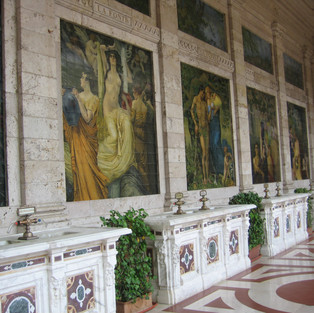The Grand Bar, Tettuccio Spa, Montecatini Terme, Italy

One of the greatest bars I’ve ever been in, certainly the biggest, was occupied at the time by just six people—the bartender, Barbara and me, and three German nuns. That was a first, drinking with nuns. Of course, we weren’t actually drinking with them. They sat at a separate table. And they were drinking coffee, not wine. And they may not have been nuns, but they dressed like nuns and they spoke German.
So that’s my story, and I’m sticking with it.
How we got to this bar, and what we did there, is a simpler tale. My wife and I were staying in Lucca, in northern Tuscany, and decided to make the two-hour drive to Modena, north of Bologna. Modena is where the world’s finest cars (Ferrari and Lamborghini) and most exquisite balsamic vinegar are made. I have no idea what the two products have in common but we heard Ferrari was giving away a free bottle of vinegar with every purchase of one of their 12-cylinder models. So we were intrigued.
We never arrived at Modena, however. Not even close. We started late and, just 20 minutes into the trip, we decided it was time for lunch. (Vacation schedules are such a grind.) But where to eat? We pulled off the autostrada at a town called Montecatini Terme. There we found not just lunch but one of the loveliest afternoons imaginable.
While trying to find our way back to the highway after lunch, my wife spotted what appeared to be a palace surrounded by ornate, manicured gardens.
“What do you think that is?” my wife said.
A few right turns (and a few wrong turns) later, we found ourselves standing at the palace entrance. Nobody was there! No cars in the parking lot. No tourists. Was it abandoned? Closed? Private? True, it was a drizzly, umbrella afternoon but even the most overlooked landmarks in Italy are usually jammed in May, no matter the time or weather. Yet, there was nobody.
We peeked in and saw the most astonishing promenade—columns, stained glass, tile, and frescoes, classic Art Nouveau architecture. We found an admission booth and a lone ticket seller. I asked her if the place were closed. No! What was this place? She told me it was a “terme” (TEHR-meh). The word, “terme” had not yet entered my Italian vocabulary so I didn’t understand her answer. But, hey, two euros apiece and we were in!

Inside, we felt we had been transported to an enchanted place created, apparently, for our private viewing pleasure. The “palace” turned out to be a series of buildings connected by grand covered walkways, canopies, really. There were reflecting pools and whimsical sculptures of frogs, herons, and wild boar. There was a fountain guarded by carved crocodiles. Surrounding the buildings were sloping lawns and terraced gardens. We found a calendar bed which was replanted every day to reflect the change in dates. I don’t think I have ever seen grounds as gorgeous as these, not even in Versailles.
And then we found the Grand Bar. It was bigger than many train stations I have passed through. The ceiling, 25 feet up, was stained glass and Belle Époque murals. The walls bore elegant landscape frescoes. The bar itself had to be 80 feet long, obviously constructed to handle vast crowds of patrons. It was mid-afternoon—Happy Hour somewhere!—so we ordered a couple glasses of Pinot Grigio and settled in.
This is what I discovered later: This was not a palazzo at all. It was Il Terme Tettuccio, an enormous public spa, quite famous in its day. “Tettuccio” means “canopy” in Italian which makes sense now.
The Tettuccio spa is one of many spas in Montecatini Terme. (Terme means “spa” or “hot springs” in Italian.) The town is the center for a lot of thermal mineral springs, and the royalty of Europe has been taking the waters there since 1800. In the 19th and the first half of the 20th century, the mineral baths drew celebrities like Giuseppe Verdi, Luigi Pirandello, and that swell guy, Benito Mussolini. Il Tettuccio itself was constructed around 1905 and was an immediate hit with affluent health nuts. Nowadays, it functions as more of a community park, festival grounds, and wedding center. Imagine the bar tab a bride’s family can run up in a saloon as big as the Grand Bar.
What made this a truly exceptional afternoon, though, was what happened next. Just outside the bar was a raised bandstand beneath a columned canopy (un tettuccio!). On the bandstand was a grand piano, and at the piano was a pianist, complete with dark suit and tie.

He did what pianists always do, he played. So we sat down at a table on the bar terrace and listened. And we were joined by a vast throng of six more people, maybe, including the nuns. He played light classical pieces at first. My wife and I were a little giddy at the unexpected treat. (The wine may have helped.) We applauded while the others sat silently. The piano guy peeked over his shoulder to see who was making all the fuss. He must have assessed our nationality pretty quickly because the next tune he played was “Take Five” by Dave Brubeck. Then Gershwin, then Ellington, even Henry Mancini, tune after American classic tune.
He was playing for us. On a dreary afternoon, in a century-old relic, in a town we had never heard of six thousand miles from home, an unknown piano man played Gershwin just for my wife and me.
We may have had more than one glass of wine that afternoon. I can’t remember.


















Comments